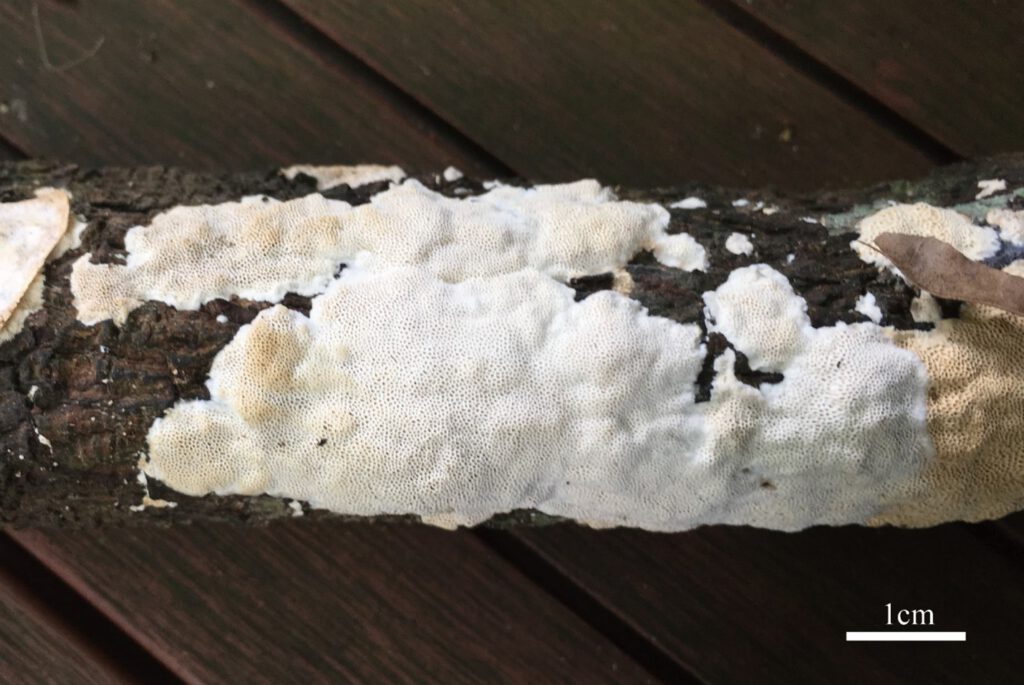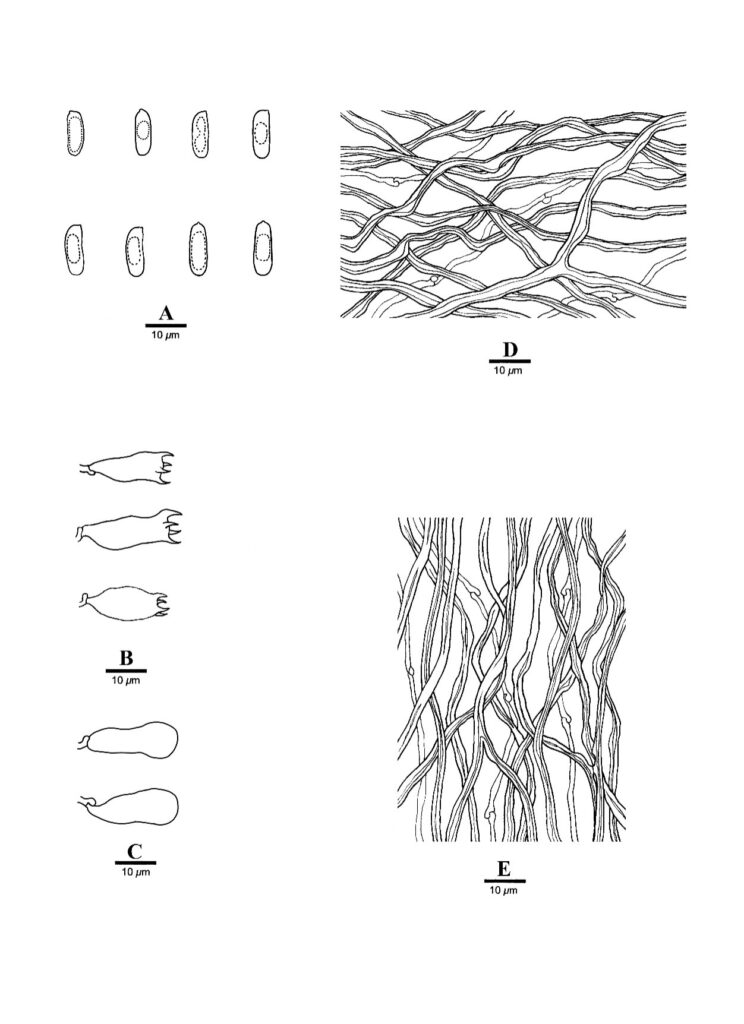Megasporoporia inflata
MycoBank Number: MB 558813; Index Fungorum number: IF 558813; Facesoffungi Number: FoF 10472;
Description
Basidiocarps annual, resupinate, cushion-shaped, corky, without odor or taste when fresh, becoming hard corky upon drying, up to 9.5 cm long, 2 cm wide, and 3.5 mm thick at center; sterile margin thinning out, cream to clay buff, up to 1 mm wide. Pore surface cream to buff when fresh, buff when dry; pores round to angular, 2.5–3 per mm; dissepiments thick, entire; subiculum buff, corky, up to 1 mm thick; tubes pale buff, corky, up to 2.5 mm long. Hyphal system dimitic; generative hyphae bearing clamp connections; skeletal hyphae strongly dextrinoid, CB+; tissues more or less dissolved and skeletal hyphae become strongly swollen in KOH. Subicular generative hyphae infrequent, hyaline, thin-walled, moderately branched, mostly flexuous, 2–2.5 µm in diam; skeletal hyphae dominant, thick-walled with a narrow to medium lumen, moderately branched, mostly flexuous, interwoven, 2–3.5 µm in diam. Tramal generative hyaline, thin-walled, moderately branched, 2–2.5 µm in diam; skeletal hyphae dominant, thick-walled with a narrow lumen to subsolid, moderately branched, mostly flexuous, interwoven, 2.5–3 µm in diam. Dendrohyphidia absent. Hyphal pegs absent. Cystidia and cystidioles absent. Basidia broadly barrel-shaped to pyriform, with four sterigmata and a basal clamp connection, 14.2–22.5 × 7–8.9 µm; basidioles dominant in hymenium, in shape similar to basidia, but smaller. Big rhomboid or polyhedric crystals frequently present among hymenium. Basidiospores cylindrical, hyaline, thin-walled, smooth, with one big guttule, IKI–, CB–, (9.8–)10–11.8(–12) × 3.5–4.2 µm, L = 10.38 µm, W = 3.86 µm, Q = 2.69–2.98 (n = 60/2).
Material examined: MALAYSIA. Selangor, Kota Damansara Community Forest Reserve, on fallen angiosperm twig, 19 June 2017, Y.C. Dai 17478 (BJFC025011, holotype). Singapore. Bukit, Timah Natural Reserve, on fallen angiosperm branch, 20 July 2017, Y.C. Dai 17882 (BJFC025414).
Distribution: Malaysia. Selangor.
Sequence data: Dai 17478 (Holotype) – ITS: MW694887.1 (ITS5/ITS4); LSU: MW694930.1 (LROR/LR7); MTSSU: MW694915.1 (MS1/MS2); EF1a: MZ618633.1 (983F/1567R) Dai 17882 – ITS: MW694886.1 (ITS5/ITS4); LSU: MW694929.1 (LROR/LR7); MTSSU: MW694914.1 (MS1/MS2);
Notes: The skeletal hyphae of Megasporoporia inflata strongly swell in KOH, and this feature is unique in Megasporoporia sensu lato. In addition, Megasporoporia inflata lacks hyphal pegs, cystidioles and dendrohyphidia. So, the above characteristics stand out the new species from other members of Megasporoporia sensu lato. Megasporia tropica is similar to Megasporoporia inflata by occuring in tropical China, almost the same size of pores, strongly dextrinoid skeletal hyphae, the absence of hyphal pegs and dendrohyphidia, but the former has cystidioles and bigger basidiospores (14.7–18.8 × 5–6.5 µm vs. 10–11.8 × 3.5–4.2 µm), and its skeletal hyphae are unchanged in KOH (Yuan et al. 2017). Phylogenetically, M. inflata is closely related to M. bannaensis (Figs. 1, 2), but the latter species has bigger pores (1–2 per mm) and their skeletal hyphae unchanged in KOH (Li & Cui 2013b).

Fig. 1. Megasporoporia inflata (neotype). Basidiocarps of Megasporoporia inflata (the holotype, Dai17478).

Fig. 2. Megasporoporia inflata (holotype). Microscopic structures of Megasporoporia inflata (drawn from the holotype, Dai 17478). (A) Basidiospores; (B) Basidia; (C) Basidioles; (D) Hyphae from subiculum; (E) Hyphae from tube.
